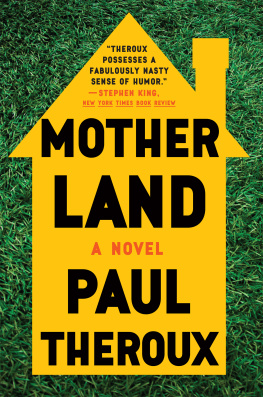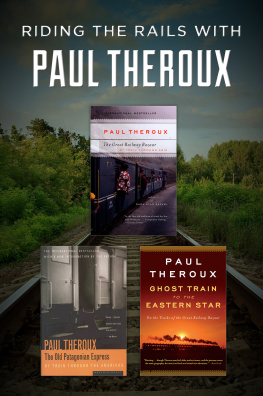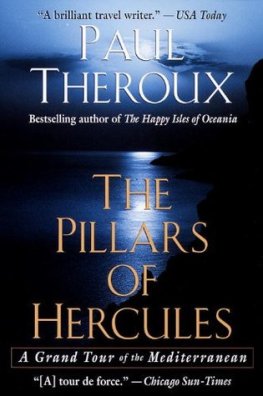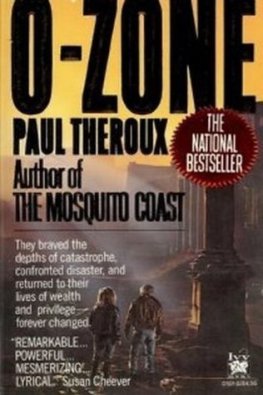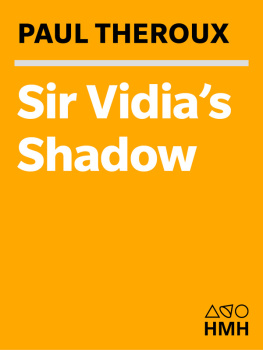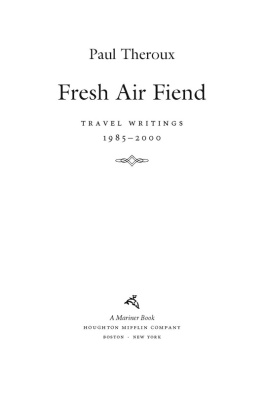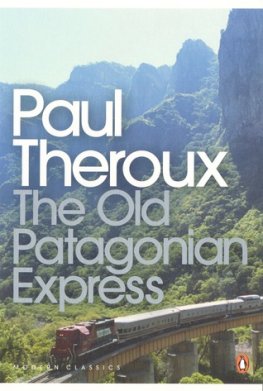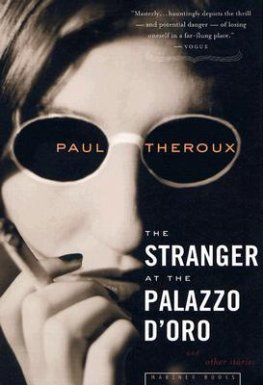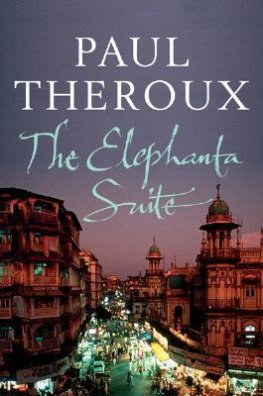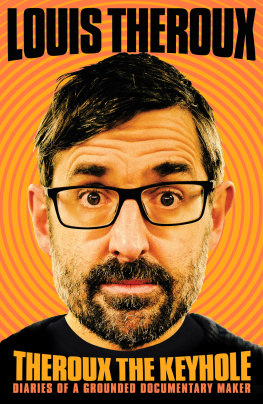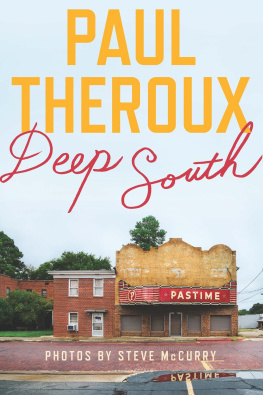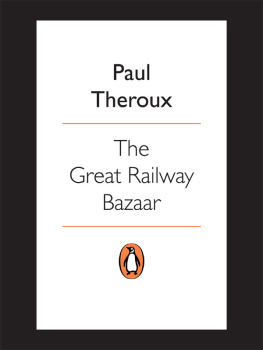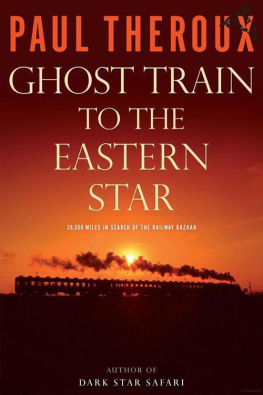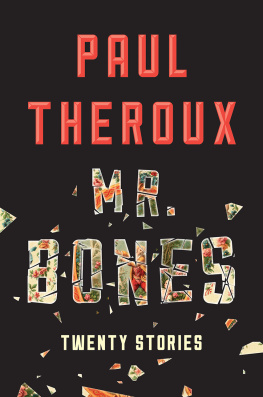Copyright 2018 by Paul Theroux
All rights reserved
For information about permission to reproduce selections from this book, write to or to Permissions, Houghton Mifflin Harcourt Publishing Company, 3 Park Avenue, 19th Floor, New York, New York 10016.
hmhco.com
Library of Congress Cataloging-in-Publication Data
Names: Theroux, Paul author.
Title: Figures in a landscape : people and places : essays: 2001-2016 / Paul Theroux.
Description: Boston : Houghton Mifflin Harcourt, 2018. | An Eamon Dolan book.
Identifiers: LCCN 2017045486 (print) | LCCN 2017048160 (ebook) | ISBN 9780544866669 (ebook) | ISBN 9780544870307 (hardback)
Subjects: LCSH : Theroux, Paul. | Theroux, PaulTravel. | Authors,
American20th centuryBiography. | BISAC: TRAVEL / Essays & Travelogues. | BIOGRAPHY & AUTOBIOGRAPHY / Personal Memoirs. | LITERARY COLLECTIONS / Essays.
Classification: LCC PS3570.H4 (ebook) | LCC PS3570.H4 A6 2018 (print) | DDC 814/.54 [B] dc23
LC record available at https://lccn.loc.gov/2017045486
Cover design by Christopher Moisan
Author photograph Steve McCurry
v1.0418
Write the vision
And make it plain on tablets,
That he may run who reads it.
HABAKKUK 2:2
Introduction: Study for Figures in a Landscape
I am a novelist and only now and then an essayist or a chronicler of my travels. How I wish it were possible for me to describe the snail trail of my fiction writingthat groping interior journey of false starts and bad days and sudden enchantmentswithout uttering pompous approximations and absurd sanctimonies. Even that rambling attempt is pretentious and irritating, so you see the problem.
If I cant stand listening to the rabid vanity of other writers talking in abstractions about their work, why should I do it myself? I am happier to see people write fiction well without moaning about how they did it. When writers complain about how tough a job writing is, making a meal of their pain, any fool can see that what they are saying is a crock. Compared with a real job, like coal mining or harvesting pineapples or putting out wildfires or waiting on tables, writing is heaven.
Besides, I am possessed by the great gnawing fear of many writers, that if I anatomize the craft of fiction writing, I might never write another word of fiction again. Better not to vapor on about it. Every writer must find the secret of fiction within. Misery helps, so does muddle and loving books, so does leaving home. I grew up with the notion, well expressed by the traveler Norman Lewis, The farther I was from home, the better it would be, and it proved to be true.
But if fiction writing is a ritual in the dark, obscure and so ungraspable that you dont understand a word of what youve written until youre done, other sorts of writing involve a plainer and more practical approach.
Writing travel. I can talk about that. I have certain guidelines. The first one is, in travel be as unofficial as possible. Evidence of the dangers of official travel is everywhere. Nothing in the world is more misleading than the sponsored visit, the press junket, the press pool, the pool feed, the fact-finding mission. The subtext of the official visit is always tendentious, and it is laziness, self-importance, and greed that impel the official visitor to accept the auspices and lap up the lies. The whole point of the red carpet is to dazzle the visitor and obscure the truth.
Ugandas doing great, President Clinton said to me at a gathering when I told him I had been traveling there.
I said, No, its not. The government is corrupt. It persecutes the opposition. Life in the bush is much worse than it was in the 1960s, when I was a teacher in Kampala. And, as I said, I was there a month ago.
Hillary just came back. The president smiled at my ignorance. Its doing great.
And now it was my turn to smile.
Who do you think you are, saying those awful things about Iran? Youre lying! Marion (Mrs. Jacob) Javits howled at me backstage in the NBC-TV studio in New York City in August 1975, after I published my first book of travels, The Great Railway Bazaar. Iran was a stable, prosperous, and well-governed country, she said. Really? I had traveled overland by train and bus from west to east, ending up in the holy city of Meshed. I heard nothing but stories of torture, repression, and tyranny from very angry Iranians, who spoke of ridding themselves of the shah. It turned out that Mrs. Javits was a paid consultant to the government of Iran, and her husband, Jacob, the U.S. senator, no stranger to Iranian junkets and free caviar, courtesy of the shah, who was overthrown fourteen years later.
There is no fate so uncertain as the fate of books of travel, Joseph Conrad wrote in his preface to Richard Curles Into the East. They are the most assailable of all mens literary productions. The man who writes a travel book delivers himself more than any other into the hands of his enemies.
In my 1988 book of China travels, Riding the Iron Rooster (name a Chinese train and I took it), I suggested that the Chinese cops, the Peoples Armed Police and the Chengguan peace officers, had a taste for beating up students. I had traveled in China for a year; I had seen many demonstrations. The conventional wisdom in the West was that the Chinese government was reform-minded and tolerant. Reviewers spanked my book. But this was a year before the Tiananmen Square massacre.
True travel and the inquiry of the essayist requires the simpler stratagems of being humble, patient, solitary, anonymous, and alert. These are not qualities one normally associates with duck-butted legislators on a fact-finding mission, or agents of virtue looking for someone to encumber with charity and free food, or journalists reporting high-level meetings, all of them in search of a welcome mat.
That I am a well-off, fairly old, semi-well-known writer who can afford to fly first class and rent nice cars and stay in good hotels makes it all the more important that I travel in old clothes, on a small budget, on a bus or train or cattle truck. My natural element (and it has been the stuff of the travel narrative since Herodotus) is the low-level meeting. In Africa in 2001, I received little enlightenment from politicians, but quite a lot from talking to truck drivers, migrants, prostitutes, and farmers. Writers are also a source of inspiration, especially those writers who seem part of a particular landscape. In Buenos Aires I sought out Borges, in Tangier Paul Bowles, in Brazil Jorge Amado, in Turkey Yaar Kamal and later Orhan Pamuk. Traveling in Africa, I spent time in Egypt with Naguib Mahfouz, and in Johannesburg with Nadine Gordimer. All travel writing and many essays seem to me to be summed up in the title of the enigmatic Francis Bacon painting Study for Figures in a Landscape.
I enjoy comfort as much as the next traveler. And no one knows better than a writer how pleasant is the life removed, how dreary it is to haunt assemblies where youth and cost a witless bravery keeps. Sound familiar? This paraphrased admonition is the Duke in Shakespeares Measure for Measure, who is a good model for the traveling writer. In order to find out what is really going on in his dukedom, the Duke says he needs to assume a humble disguise, such as a friars habit, to visit both prince and people.
The example of Harun al-Rashid, caliph of Baghdad in the eighth century, is also salutary. The caliph habitually disguised himself as a commoner and went to the marketplace to find out how people lived, what complaints they had, what exercised their minds, what made them proud. The great travelers of the past peregrinated in this same mood of discoverythe medieval friars who visited China, the Japanese mendicants, the wandering diarists quoted extensively by the French historian Fernand Braudel in my favorite of his books,

